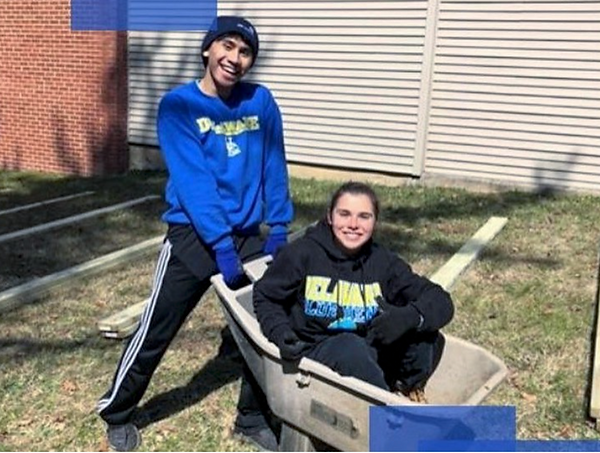
expressing equity through...
wilmington green box
For both Tier 2 and Tier 3 of the Blue Hen Leadership Program, I matched with the local non-profit organization Wilmington Green Box (WGB). The experience of working closely with a non-profit in the company of other students provided me the learning opportunity of project management and the learning opportunity of applying the theoretical aspects of organizational leadership in a team setting.

wgb mission
Wilmington Green Box is a 501(c)3 based in Wilmington, Delaware. The goals of the non-profit is two-pronged: (1) provide healthy goods to the city of Wilmington, and (2) employ at-risk youth in the city of Wilmington with an entrepreneurial learning opportunity.
When I worked with WGB, they had plans to develop and sustain an urban garden which will serve as a way to grow their own produce, engage community members to assist with nurturing the garden, and to employ more at-risk youth via gardening education and management.
tier 2:
the engaged leader
The goals for Tier 2 is to engage students in learning about the Social Change Model, specifically the group lens. Tier 2 students are grouped together, partnering with a non-profit organization as a learning opportunity to explore group dynamics, team effectiveness via Five (Dys)Functions of a Team, psychological safety, and Strengths/Saboteurs.
Through Wilmington Green Box, my team developed and ordered supplies for the urban garden project and established the literal groundwork for the garden boxes. Before any plans were made, group dynamics were established through team charter development, site visits to gauge garden space and to meet the non-profit. Since we had a team of 6 people, communication and keeping people in the loop was paramount. With such an important task, I took upon the role as the Scribe to ensure that all teammates were up-to-date on information.


Personal Group Work Statement
Within group dynamics, effective teams cannot produce the best efforts without establishing trust. In every group situation I participate in, I take the moment to perform a team check-in. Team check-ins allow for people to be able to express what has been going since the last meeting and allows for bonding. With the intention of understanding group members, personal strengths can surface and allow for the designation of team roles centered around strengths which will smooth team operations and lead to optimal team efficacy!

Conflict management philosophy
Conflict is healthy in group settings. The presence of conflict means the presence of opinion differences, signaling that group think is absent. However, the venue of how conflict is expressed should be funneled in a healthy, productive manner which involves the usage of I-Statements, Empathetic Listening Skills, and most importantly, Psychological Safety. Psychological Safety is the result of individuals feeling comfortable enough to speak up without fear of negative interpersonal repercussions. When a person feels safe enough to engage in conflict, the next step would be to allow that individual to feel heard through asking open-ended questions, "yes, and..." responses, and ultimately reframing conflict as a tool and opportunity to form solutions.



tier 3: community engagement fellows
Since COVID-19 halted the development of the urban garden for Wilmington Green Box, I was adamant in continuing my relation with Wilmington Green Box and to finish what I started.
From September to December, our team visited the site, interviewed the board members, and completed a SWOT analysis. During the site visit, we met up with George, a local landscapist, and he identified that we needed to secure water lines. This was the start of starting communications with the City of Wilmington and other formal processes for infrastructure development. The SWOT analysis was used to develop final project ideas in which we pitched to the board.
[SWOT] [Pitch}
From December to February, we finally were able to secure a water line after repeated phone calls and meetings with the board members of WGB and other city officials. We built it in the garden thanks to the help of the City of Wilmington. We also developed research and created guides on how to use specific sustainability projects that can be implemented once the garden was ready. While these were ideas from Tier 2, having accomplished one aspect from Tier 2 despite COVID was gratifying.
February to April, we started collaborating with a local non-profit, The Urban Garden Initiative, a local non-profit ran by a high school student, Megan Chen. We set up a curriculum for Jason's teenagers to engage with as we prepare the garden
Outcomes & impact
Due to our team's values driving us to complete the project, we were able to establish a working water line to the garden plot. The process was lengthy and I learned that persistence is key. In order to inspire a shared vision, I had to consistently call the city of Wilmington to ensure that we were able to establish a line to show not only urgency but also how important the project meant to me. I learned so much from Jason and his hands-off approach. Taking initiative with the project and its various scopes allowed us to set up WGB for success. In addition, our team learned that we should rely on our strengths. Leadership is contextual dependent on strengths and what your skill sets are. As students in the health sciences, our strengths do not lay in landscaping, but as student leaders we were able to delegate those tasks to more qualified community members.